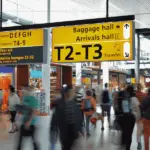In a significant policy change that reflects growing aviation safety concerns, a second airline has announced a comprehensive ban on the inflight use and charging of power banks and spare lithium batteries across its entire fleet. The new regulation, set to take effect on March 1, 2025, marks an important shift in how airlines are addressing potential fire hazards associated with portable power devices during flight. This development comes amid a series of incidents involving lithium battery fires on commercial aircraft.

The New Policy: Understanding the Restrictions
The Taiwanese carrier’s announcement details specific prohibitions that will impact how passengers manage their electronic devices during flights. Under the new policy, travelers will no longer be permitted to connect power banks to their devices or charge spare lithium batteries at any point during the flight, regardless of aircraft type or flight duration. This prohibition extends from boarding to disembarkation, effectively eliminating a common practice among travelers who rely on portable power sources during long-haul journeys.
Eva Air’s policy maintains existing international aviation regulations regarding transport of these devices—power banks and spare lithium batteries remain strictly prohibited in checked luggage due to the impossibility of monitoring and containing potential fires in the cargo hold. These items must continue to be carried in the cabin, where crew members can respond to incidents, but must now remain disconnected and properly stored throughout the flight to prevent compression or damage that could trigger thermal events.
The airline has emphasized that this policy change prioritizes passenger safety over convenience, acknowledging that while many travelers have come to rely on portable power sources during flights, the risk management benefits outweigh passenger inconvenience. To mitigate this inconvenience, Eva Air has highlighted that most seats across its fleet feature built-in AC power outlets and USB Type A charging ports, providing alternative charging options for passengers with depleted devices.
The Technical Background: Understanding Lithium Battery Risks
The science behind lithium battery restrictions helps explain why airlines are increasingly cautious about these devices. Lithium-ion and lithium-polymer batteries, which power everything from smartphones to laptops and portable chargers, store substantial energy in compact forms. This energy density makes them ideal for consumer electronics but also creates unique safety challenges, particularly in pressurized aircraft cabins.
When damaged or defective, these batteries can experience “thermal runaway”—a chain reaction where rising temperatures trigger chemical releases that further increase heat, potentially leading to fires that can reach temperatures exceeding 1,000 degrees Fahrenheit. Unlike conventional fires, lithium battery fires are difficult to extinguish with standard fire suppression methods. These fires can release toxic gases and propagate rapidly to nearby flammable materials, presenting particular challenges in confined aircraft cabins.
The risk factors for lithium battery failures include physical damage from impacts or compression, manufacturing defects, exposure to extreme temperatures, electrical shorts, and charging irregularities. The aviation environment can exacerbate several of these factors, with cabin pressurization changes, turbulence-related impacts, and the proximity of numerous devices creating conditions where battery failures become more likely or more dangerous.
Industry data suggests that while catastrophic battery failures remain statistically rare given the billions of devices in circulation, their consequences in aviation contexts are potentially severe enough to warrant precautionary measures. International aviation authorities record dozens of incidents annually involving smoking, overheating, or burning lithium batteries on commercial flights, with each incident representing a significant safety challenge for crew members.
Recent Incidents: Catalysts for Change
Eva Air’s policy announcement follows several high-profile incidents involving lithium battery fires on passenger aircraft. Perhaps most influential in regional policy development was a January incident aboard an Air Busan flight bound for Hong Kong from Busan, South Korea. During this flight, a fire erupted in an overhead compartment, forcing an emergency response from the crew. While the exact cause remains under investigation, preliminary reports indicated that an electronic device or power bank likely initiated the fire.
This incident triggered immediate regulatory responses across Asian carriers, with the South Korean government announcing similar restrictions on power banks and electronic cigarettes in overhead bins of Korean-owned airlines, also effective from March 1, 2025. The synchronization of these policy implementations suggests coordinated regional approaches to addressing what is increasingly viewed as a common safety concern.
Beyond this recent incident, aviation safety databases contain numerous examples of lithium battery incidents across global carriers. These range from minor smoking events handled with onboard extinguishers to more serious fires requiring emergency diversions. In several documented cases, power banks showing no external signs of damage have spontaneously combusted during flights, sometimes while actively charging devices and in other cases while simply stored in carry-on bags.
The accumulation of these incidents has shifted industry perception of lithium battery risks from theoretical concerns to practical safety priorities. Aviation safety experts note that as battery capacities increase to meet consumer demands for longer-lasting portable power, the energy involved in potential failures also increases, amplifying risk profiles.
Industry Trends: A Shifting Approach to Electronic Devices
Eva Air’s announcement represents part of a broader evolution in how the aviation industry manages passenger electronics. This evolution has moved through several distinct phases over the past two decades, reflecting both technological developments and evolving risk assessments.
In the early 2000s, concerns centered primarily around potential electromagnetic interference with aircraft systems, leading to restrictions on device use during critical flight phases. As aircraft systems became more robust against interference and evidence of actual risks remained minimal, these restrictions gradually relaxed, culminating in widespread gate-to-gate device use policies by the mid-2010s.
Attention then shifted to lithium battery fires, particularly following high-profile incidents involving early smartphone models and e-cigarettes. Initial responses focused on specific device types or brands with identified defects, resulting in targeted prohibitions rather than broad restrictions on device categories.
The current phase, exemplified by Eva Air’s announcement, reflects a more comprehensive approach based on device functionality rather than brand-specific concerns. This risk management strategy acknowledges that thermal events can occur with devices from any manufacturer and focuses instead on the contexts in which risks become elevated—namely, the charging process and improper storage.
Industry analysts suggest this trend may continue, with future policies potentially distinguishing between different battery capacities or technologies rather than implementing blanket restrictions. Some carriers have already begun exploring enhanced screening processes for high-capacity batteries and specialized containment solutions for managing inflight battery incidents.
Passenger Impacts: Adapting to New Realities
For frequent flyers, particularly those on Eva Air’s long-haul transpacific routes, the new restrictions will require adjustments to established travel routines. Business travelers, digital nomads, and tourists who typically rely on continuous device use throughout lengthy flights will need to implement alternative power management strategies.
The most immediate adaptation involves ensuring devices are fully charged before boarding, potentially requiring longer pre-flight time at airport charging stations or terminal facilities. For travelers with multiple devices, power management becomes more critical, with strategic device usage necessary to maintain function throughout longer flights.
Passengers with specialized medical devices that require continuous power supply should note that the restrictions include exceptions for essential medical equipment, though documentation requirements may apply. Entertainment-focused travelers might consider downloading content before flights rather than streaming, which typically consumes more battery power.
The impact extends beyond personal convenience to potential business productivity concerns, particularly for routes exceeding 12 hours where built-in power systems may be insufficient for continuous device operation. Business travelers may need to incorporate battery conservation strategies such as reduced screen brightness, offline work modes, or strategic device cycling to maintain productivity during ultra-long-haul journeys.
Travel accessory manufacturers have already begun marketing products designed to maximize pre-flight charging efficiency, including multi-device charging stations and high-capacity integrated battery cases that technically function as part of the device rather than as separate power banks, though the regulatory status of such accessories remains somewhat ambiguous under the new policies.
Competitive Landscape: Industry Divergence and Convergence
Eva Air’s announcement highlights interesting dynamics within the competitive aviation marketplace regarding safety policies and passenger convenience. While many carriers implement similar restrictions due to shared regulatory environments and risk management considerations, differences in timing and scope create temporary competitive distinctions that can influence passenger booking decisions.
Some carriers have taken more aggressive approaches, implementing full bans earlier or extending restrictions to encompass broader device categories. Others maintain more permissive policies, balancing safety considerations against passenger convenience, particularly on routes where inflight power access represents a significant competitive differentiator.
These differences create short-term market segmentation, with passengers potentially selecting carriers based partly on electronics policies. However, industry experience suggests that safety-related policies typically converge over time as best practices emerge and regulatory pressures normalize. This pattern of initial divergence followed by gradual convergence has characterized numerous aviation safety developments, from smoking restrictions to seatbelt requirements.
For Eva Air specifically, the timing aligns with similar announcements from regional competitors, creating a relatively level competitive landscape within its primary market segments. This synchronized implementation reduces the likelihood that the carrier will experience significant passenger migration to competitors based solely on electronics policies.
Industry insiders suggest that complete global standardization remains unlikely in the near term, with cultural differences in risk tolerance, varying regulatory frameworks, and diverse fleet compositions continuing to influence carrier-specific approaches to lithium battery management.
Regulatory Context: Beyond Individual Airline Policies
Eva Air’s policy implementation exists within a complex regulatory framework established by international aviation authorities, particularly the International Civil Aviation Organization (ICAO) and its member states’ civil aviation authorities. These bodies establish baseline requirements for lithium battery transport, which individual carriers may exceed but not diminish.
Current ICAO dangerous goods regulations prohibit lithium batteries in checked baggage and restrict loose batteries in cabin baggage based on watt-hour ratings. Most consumer power banks fall under the allowable limit of 100 watt-hours per battery, with special permission required for items between 100 and 160 watt-hours. Anything exceeding these limits is prohibited on passenger aircraft altogether.
National aviation authorities frequently supplement these international standards with country-specific requirements. The Civil Aeronautics Administration of Taiwan, which oversees Eva Air as the flag carrier, maintains alignment with ICAO standards while occasionally implementing more stringent requirements based on regional risk assessments or specific incident responses.
What makes Eva Air’s announcement noteworthy from a regulatory perspective is its focus on inflight use rather than transport alone. While transport regulations remain relatively stable, operational restrictions regarding when and how passengers may use personal electronic devices continue to evolve more dynamically, often driven by airline-specific risk assessments rather than regulatory mandates.
This creates a graduated regulatory landscape where baseline transport requirements remain consistent internationally, while operational policies during flight show greater variation between carriers and regions. Aviation analysts predict this pattern will persist, with transport regulations evolving slowly through formal ICAO processes while inflight usage policies respond more rapidly to emerging safety data.
Technology Solutions: Addressing the Core Concerns
As restrictions on lithium battery use increase, technological developments aimed at addressing the underlying safety concerns continue to advance. These innovations fall into several categories, each approaching the challenge from different perspectives.
Battery chemistry improvements represent perhaps the most fundamental approach, with manufacturers researching alternatives to conventional lithium-ion formulations. Solid-state batteries, which replace flammable liquid electrolytes with solid compounds, show particular promise for aviation applications due to their significantly reduced fire risk and improved thermal stability. However, mass commercialization of these technologies remains several years distant.
Enhanced battery management systems provide a more immediate safety improvement, with sophisticated monitoring technologies capable of detecting potential failure conditions before they escalate to thermal events. These systems can automatically disconnect power when abnormal conditions are detected, preventing many common failure modes that lead to inflight incidents.
For airlines, specialized containment technologies offer practical solutions for managing battery fires when they do occur. Several manufacturers now produce fire-resistant bags and containers specifically designed for lithium battery fires, providing flight crews with effective tools for isolating and controlling thermal events until landing.
The consumer electronics industry has responded with products designed to address aviation safety concerns while maintaining functionality. Some manufacturers now offer power banks with integrated thermal fuses, automatic shutdown capabilities, and physical protection against compression damage—all features that could eventually influence future aviation policies regarding these devices.
While these technological developments may eventually lead to relaxed restrictions, industry experts caution that significant policy changes would require robust data demonstrating substantially improved safety profiles, likely requiring years of operational experience with next-generation battery technologies.
Communication Challenges: Informing the Traveling Public
A critical aspect of Eva Air’s policy implementation involves effectively communicating these changes to a diverse international passenger base. The airline faces the considerable challenge of ensuring policy awareness across multiple languages, cultures, and travel contexts.
The carrier has initiated a multi-channel communication strategy, distributing information through its website, social media platforms, email notifications to frequent flyers, and updates to booking confirmations. Pre-departure reminders and gate announcements will supplement these efforts, along with updated inflight safety briefings incorporating the new restrictions.
Despite these comprehensive efforts, passenger awareness gaps inevitably occur during major policy transitions. Industry experience suggests that even well-communicated aviation policy changes typically require several months before reaching near-universal passenger awareness, creating a transitional period where crew enforcement becomes particularly important.
For international carriers like Eva Air, cultural and linguistic factors create additional communication complexities. Safety concepts and technical terms surrounding lithium batteries translate with varying effectiveness across languages, potentially creating confusion regarding exactly which devices fall under restriction categories.
To address these challenges, visual communication plays an increasingly important role, with pictographic representations of prohibited activities supplementing text-based information. The standardization of these visual elements across carriers and airports could significantly improve passenger comprehension, particularly for infrequent travelers encountering these restrictions for the first time.



